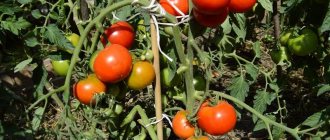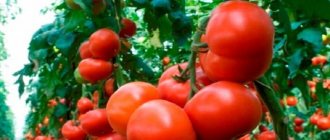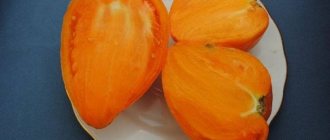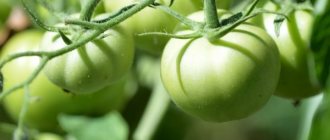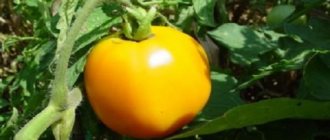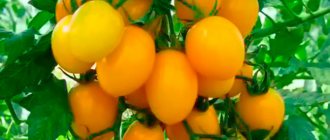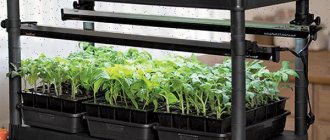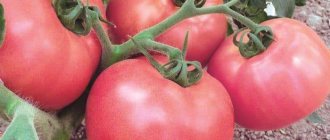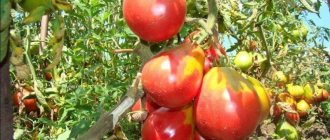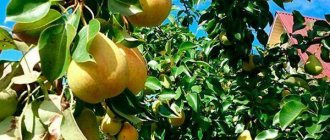Palmyra tomatoes are ideal for canning and other processing, including freezing and drying. Elongated bright orange fruits with a lot of pulp retain their shape well and do not become limp from high and low temperatures.
| Height | Landing location | Ripening time | Fruit color | Fruit size | Origin | Fruit shape |
| Tall | Greenhouse | Mid-early | Orange | Average | Variety | Plum-shaped or oval |
Description and characteristics of the variety
The variety was obtained jointly with the agro-Moscow Research Institute of Health Protection and was included in the register in 2008. The tomato is recommended for cultivation under film in the following regions:
- Northern;
- Northwestern;
- Central;
- Volgo-Vyatsky;
- Central Black Earth;
- North Caucasian;
- Middle Volga.
Medium early variety. The first fruits ripen 90 days after picking the seedlings in the phase of 2 true leaves.
Plants of unlimited growth, 190-200 cm high. Few leaves. The plates are dark green and medium in size.
On a simple inflorescence, elliptical-shaped fruits with weakly expressed ribbing ripen. When unripe, tomatoes are light green, when ripe they are orange. There are 2-3 seed chambers. Average fruit weight is 90 g.
Palmyra, like many yellow-fruited varieties, has an excellent taste. The fruits accumulate a lot of sugar and carotene.
Advantages and disadvantages of the variety
The Palmyra tomato has advantages:
- ease of care;
- attractive appearance of the fruit;
- excellent taste characteristics of tomatoes;
- productivity;
- long shelf life;
- endure transportation without loss of presentation;
- can be grown for sale;
- fruit seeds are suitable for cultivation.
The following disadvantages are highlighted:
- the need for pinning and tying to supports;
- When eating tomatoes fresh, the skin feels hard;
- It is possible to grow only in a greenhouse or under film.
Features of cultivation and storage
Tomatoes are sown 2 months before moving the seedlings to a permanent place. The seeds are disinfected for 20 minutes in potassium permanganate, then soaked for 24 hours in clean water.
Seedlings must be grown with picking - this technique makes the seedlings stronger.
Distribution into cups is carried out at the stage of formation of the second true leaf. Immediately after picking, keep the tomatoes in a cool room with a temperature of 15-18 degrees for 3-4 days. This is necessary to strengthen the roots.
High-quality seedlings have 6-7 true leaves and one raceme.
Growing tomatoes
Sowing of seedlings begins 60-65 days before transplanting into the greenhouse. Today, seed producers carry out all preparation procedures. Therefore, you can immediately sow purchased seed into moist soil.
Seedlings can be grown in individual cups, peat tablets or pots. But before sowing, any container, except peat, must be treated with a thick solution of potassium permanganate.
Fertile, loose, light soil is suitable for Palmyra tomatoes.
The prepared soil mixture is poured over the drainage layer and compacted well. Grooves 1-1.5 cm deep are made on the surface. Seeds are carefully placed in them at intervals of 3-5 cm. They are covered with a layer of soil on top. The crops are generously moistened with a spray bottle.
To create a favorable environment for germination and the appearance of friendly shoots, the containers are covered with glass, a lid or plastic film.
Water the seedlings carefully around the perimeter of the container as the top layer of soil dries. Avoid overdrying or overmoistening. Only warm water is used. Fertilizing with mineral complexes for seedlings is carried out 1-2 times with watering.
In the phase of formation of the first two true leaves, seedlings are picked. This procedure is mandatory for the Palmyra variety. Since its bush is tall, it needs a developed root system. Diving contributes to its formation. In a larger container, the tomato actively increases in growth, and when transplanted to a permanent place, it suffers less.
Transplantation into the ground
Shallow holes are dug for planting. They contain humus, fertilizers, and growth stimulants. The seedlings are fixed in the center, the roots are covered with soil. After immediately watering, the earth is immediately mulched to avoid moisture loss.
Features of care
Immediately after planting, supports are installed to which the stem is tied. Then the bushes are tied up as they grow.
A bush of 1-3 stems is formed. To do this, the side shoots are removed, with the exception of 2, which are located above and below the flowering raceme. Then pinching is carried out regularly. Watering is carried out at the root with warm water once every few days. We must try to avoid getting moisture on the leaves. Loosening and hilling enrich the soil with oxygen and promote the development of the root system.
Feeding is carried out 2 times per season. Both mineral complexes and organics are used. The first time Palmyra tomatoes are fed during the flowering period, the second time - during the abundant ripening of fruits.
Planting and care
2-3 plants are planted per square meter. The bush requires shaping and gartering. When pinching, all lateral branches are removed, except for two - those that grew before and after the first flower cluster. Thus, each plant is grown in three stems.
The fruits are harvested in the phase of full ripeness, when they have the brightest color possible.
Tomatoes are frozen washed and blanched, placing them in the freezer in small portions in plastic bags.
During growth in the greenhouse, 2 feedings are carried out with azophoska (tbsp per 10 liters of water per 1 sq. m):
- During flowering.
- During the period of mass ripening of fruits.
Recommended tomato varieties
Early maturing / Tall
Pink Dream F1 User rating: 4/5
Mid-season / Tall
Pink Lady F1 User rating: 5/5
Mid-season / Tall
Mrs. Schlaubach's Famous Strawberry User Rating: 5/5
Mid-season / Tall
Korean long-fruited User rating: 5/5
Basic ideas about the variety
Detailed characteristics of the variety are studied by beginners for a reason. This information helps to correctly place the plant on the site and avoid mistakes when growing.
Bush:
- Indeterminate,
- 1.9-2 m tall.
- 5-8 tomatoes per brush.
- Ripens within 105-110 days.
Fetus:
- Orange color. Elongated shape.
- Weight 90 g, length 8-10 cm.
- The pulp is dense.
- Great taste.
- Keeps for a long time.
- Tolerates transportation well.
II. Indeterminate varieties (unlimited growth)
These are tomatoes that will grow until they turn blue until the owner or the onset of the cold season stops them. They have great yield potential, which is more successfully realized in high greenhouses. We place approximately three bushes on 1 square. With supports such as strong trellises, open ground is not prohibited, which will be especially welcome in the southern regions.
Tomato Scarlet candles
Good for pickling, sweet. This is a patented mid-early variety (Siberian breeders distinguished themselves!). In the state register since 2007. They are characterized by a high ability to form ovaries in any conditions. From 1 sq.m you can actually get a bucket and a half. The clusters are arranged in tiers, the weight of the fruit on the lower branches reaches 120 g, on the top ones - half as much.
READ MORE: Peony Red Charm: description and characteristics of the variety, subtleties of cultivation, preparation for winter
Very lightweight. A mid-early Siberian variety for canning whole vegetables. The fruits are elongated, reaching (maximum in our conditions) 13-14 cm in length, weighing about 120 g, and have a beautiful crimson hue. They have few seeds, are very fleshy, strong, and easy to keep. If they are picked green, they do not spoil and ripen perfectly. The variety is very responsive to high-quality fertilizing.
The longest
A new product of Siberian selection. It begins to ripen already on the 110th (you can add a couple more) days from the sprouts appearing on the surface of the soil. Fruits have a unique length - 20 cm (specific size)! They are very elongated, with a small pear-shaped constriction in the upper part, uniformly slightly expanding downwards, with a spout.
High yield
The variety is productive and unpretentious. Tolerates slight shading. It ties well. Neither high nor low temperatures are scary. It succeeds in protected soil, but outdoor cultivation is not prohibited. Tomatoes begin to ripen in 106-113 days; at the same time, the plant successfully continues to grow and form clusters - up to 10 pieces per bush.
Each bears up to eight graceful fruits - cylindrical and pointed, in full ripeness - iridescent pink in color. The weight of each vegetable is 100-120 g. They contain a high percentage of sugars and dry matter. They do not burst when pickled, are good for drying, obtaining thick juice and, oddly enough in your opinion, for making tomato jam. With diligent care, the bush can bear up to a bucket of quality fruit.
Tomato Niagara
Weighty brushes
This mid-early vegetable variety has been on the state register since 2010. The bush is tall, but compact in width. It has a highly branched root system, responsive to increased nutrition and good water supply. A valuable feature of this Siberian variety is its multiple clusters, each of which bears up to 14 fruits weighing 85-115 g.
Meaty and sweet
This is one of the sweetest and meatiest products of Siberian breeders. It has been registered in the state register since 2007. The tomato is mid-season (116-118 days from the appearance of sprouts), with large foliage. The fruits resemble long, sharp peppers - they grow up to 15 cm. They are an elegant red color, the weight ranges from 120-185 g. The pulp of vegetables contains very little water and seeds. In the best case, there are up to a dozen fruits in one cluster. One bush gives 2-3 kg.
Tomato Koenigsberg
Excellent ovary
Included in the state register in 2005. The variety rightfully takes its place among the most productive Siberian varieties (up to 20 kg per square meter of land in a greenhouse). It sets perfectly even in the hot atmosphere of closed ground. Plants with a powerful bush with large leaves require increased nutrition and careful pinching.
The first ovary is formed after the growth of the 12th leaf, then inflorescences are formed every 3 leaves. Refers to varieties of medium ripening; in Siberian conditions, approximately half of the crop ripens; the rest of the fruits turn red quite well when ripened. Tomatoes in the lower clusters of vegetables weigh 300 g, and in those above - no less than 150 g. The shape is elongated, heart-shaped, smooth, and beautiful.
Vitamin and sweet
Ripe tomatoes have a golden-orange color and contain a record amount of carotene vitamins. The pulp is sweet and aromatic, like berries and fruits. The ripening period is average. The lower fruits are capable of filling up to a mass of 400-450 g, higher up the bush - 200-300 g. They are oval, often with a spout. The plants grow clusters through the leaves, each containing on average, as stated, up to 5 fruits. Productivity is high. The keeping quality is excellent. It is especially tasty when salted with gelatin.
Harvest hearts
Close internodes and a powerful trunk with dense foliage are like standard varieties, only the height is two meters. The Siberian breeding novelty produces half a bucket of fruit from one such “tree”. Ripening begins on the 115th day. Forms up to 6 beautiful clusters with 5-7 red tomatoes weighing 200-250 grams, shaped like strawberries.
Tomato Budenovka
Resistant to cracking
The variety is an improved version of Ox Heart, with a higher yield (about 9.4 kg per square), early ripening, good resistance to diseases (even to late blight) and cracking of the apical tissue of the fruit for a fleshy variety. Heart-shaped, ribbed tomatoes with excellent taste.
Record weight
The variety is a new product from a team of breeding scientists under the leadership of V.F. Gavrisha. Registered in the state register in 2015. Due to the unrealistically large fruits of vegetables, it is included in the “Russian Hero” series. The variety is not very fast in terms of ripening time (from 120 days), therefore it requires early planting of seedlings, especially careful pinching and decent feeding.
In Siberia and Central Russia it works well only in closed ground conditions, including a greenhouse. The average return from a bush is 3.6 (plus or minus) kg, the record is 7 kg. The tomatoes are flat-round, slightly ribbed, have an excellent smell and are very juicy, each weighing 400-600 g, not uncommon - 800 g. There are 2-3 tomatoes in one cluster of plants; if you leave only one tomato in it, it can pull more than 1 kg. Such “bogatyrs” are better suited for salads and distillation for juice.
Bowl of salad from one fruit
One of the best salad novelties, the yield is high. The plant bears 5-6 racemes. The fruits look very attractive due to their raspberry-pink color, large up to 500-800 g. The tomatoes are flat-round, ribbed, sweet. There is high resistance to cracking; The pulp density is average. A rare quality for large-fruited varieties: the fruits do not tend to quickly soften and spoil during storage.
According to the ripening period, the variety is classified as mid-early and mid-ripe. Perfect for preparing preparations: tomato paste, juice. This tomato variety is characterized by high yield. You can remove up to 5-6 kilograms of tomatoes from one bush.
Giant orange sweet
It has plasticity, rare for a large-fruited variety, and relative unpretentiousness. Delicate sweet pulp combines with excellent keeping quality. The tomatoes are round-flat (their “ribs” stand out a little), sunny orange in color. The average weight of a tomato is 0.5 kg, but in reality there are 1 kg of fruit on the bush.
Description
If there is a small greenhouse on the site, and you want to grow a lot of tomatoes, then you need to plant high-yielding hybrids in it. Tomato hybrids must have the following qualities:
- high productivity;
- precocity or ultra-precocity;
- high commercial quality of fruits;
- resistance to diseases and viruses;
- taste qualities;
- transportability and keeping quality;
- frequent arrangement of clusters with fruits in short internodes;
- continuous formation of inflorescences and racemes.
You should not use late-ripening tomato hybrids for greenhouses, since the growing season of the plant coincides with the rapid development of fungal infections and you may not get the desired harvest.
Tomatoes are one of the most popular vegetable crops; we plant them for vitamins for the summer table and tasty preparations. And if the area of the greenhouse or garden bed is limited, high-yielding varieties are needed to produce more useful fruits. Modern tomato hybrids must provide the following qualities:
- precocity;
- high yield;
- resistance to major tomato diseases;
- commercial properties of fruits: uniformity in size and shape, attractive color, absence of cracking, keeping quality and transportability;
- good taste of fruits;
- short internodes of shoots, compact arrangement of inflorescences;
- strong, short inflorescences bearing 5-7 fruits;
- the ability to continuously form fruit clusters – a generative type of development (for greenhouse indeterminate bushes).
What tomatoes can be called high-yielding? In quantitative terms, these are varieties and hybrids, from one bush of which we can get 10 or more kilograms of fruit. In greenhouses, when grown year-round, they yield up to 40-50 kg per sq.m.
Read about the Zozulya cucumber variety here.
Palmyra bushes belong to the indeterminate type of tomatoes, suitable for growing anywhere - both in open ground and in greenhouse conditions. Bushes reach large sizes: those planted on the street grow up to 2 meters, those planted in a greenhouse - even higher by 20-30 centimeters. Such large sizes make it clear that the plant must be tied up. Otherwise, the bush will break under the load of berries or fall to the ground under a gust of wind, causing the destruction of the crop.
Fruits The shape of the berries of this variety is unusual - the fruits are oblong and slightly elongated, reminiscent of peppers, each approximately 9-10 centimeters in length. The peculiarity is the protrusion at the end of the fruit, the so-called “spout”. The color is lemon-orange. The skin is quite thick and durable, which allows you to transport vegetables over any distance without harm to them. The taste is very pleasant, slightly sweet, and the pulp contains a lot of juice.
Suitable for all types of canning, suitable for freezing. These tomatoes can also be dried - in this case, all the beneficial substances will be preserved, which will be very useful in winter.
tomato Padishah - description and characteristics of the variety
What summer residents say about Palmyra tomatoes
Various reviews about the variety mostly characterize the plant positively. By sharing their experiences and impressions, gardeners help beginners make their choice.
- Elena. I liked everything and recommend growing it in a greenhouse. Calls it a “hard worker”, since the ovaries are formed without a gap.
- Svetlana. I planted the variety in a greenhouse and formed it into 2 stems. The taste is excellent and they last a long time.
The high density of Palmyra tomatoes allows them to be grown for sale or storage.
I. Hybrids
Hybrid tomatoes are virtually guaranteed to be resistant to diseases and bad weather conditions, which is something that non-hybrid varieties suffer from. Greenhouses and greenhouses are valued for storing heat, but in them tomatoes can suffer from too high temperatures and sudden temperature changes. In recent years, world selection has been aimed at producing “heat-resistant” hybrids with a reliable guarantee of ovary production.
Hybrids are especially helpful in a greenhouse or a small garden plot where there are no real opportunities for crop rotation and diseases are prevalent. Selection successes demonstrate confident resistance to various types of infections - viral (especially the most dangerous tobacco mosaic virus), fungal, bacterial. In addition, the hybrids have uniform fruits and consistently high yields.
READ MORE: Is it possible to feed peppers with yeast, how to get the right recipes
Tomato Incas F1
One of the best hybrids for canning whole fruits without skin. Popular early high-yielding bush hybrid. The plant is medium-sized, compact.
Tomato from the Dutch company Numens, zoned in Russia; entered into the state register in 2000. Mid-early hybrid (105 days) of meter-high vegetables, determinate. Very high resistance to fungal diseases has been recorded. The fruits are 80-100 g, dense, bright red, pepper-shaped, fleshy, uniform, tolerate sunburn well, are very easy to ripen, transported over long distances without loss of quality.
Tomato Torquay F1
Dutch hybrid from Bejo Zaden; in the Russian register since 2007. Mid-season tomato (119-123 days from germination to ripening), bush type - determinate, maximum height 100 cm. Forms abundant multiple clusters with fruits weighing 60-140 g. Dense tomatoes withstand long-term transportation, excellent in pickling and pickling matters.
Tomato Mariana F1
The tomato was created in the French branch of the Japanese company Sakata (the image of the woman Mariana is a symbol of the French Republic). The breeders of this agricultural company are often suspected of producing GMOs, but so far without real evidence. Mariana is a mid-early determinate hybrid. The fruits are similar in shape to Incas - also elongated-oval, perfectly smooth, super dense.
Tomato Bagheera F1
Hybrid from the leading French seed company Cloz. Included in the Russian seed register in 2007.
Early high-yielding hybrids are a real boon for the garden. They are cold-resistant, do not need pinching or tying up, and practically do not get sick. The ripening period is marked as medium-early; determinate bush. The fruit is round, flattened on top, ribbed, weight ranges from 80-220 g. The hybrid is resistant to soil drought and nematode, more suitable for regions located in the south. Does not suffer from fusarium and verticillium wilt.
Tomato F1 Semko 2005
The tomato is suitable for open ground and under film shelters (greenhouses). Determinate, medium-sized, compact. Resistant to soil salinity, drought, high temperatures, grows well in open ground in both southern and northern regions. Vegetables practically do not suffer from viral and fungal diseases, even late blight.
Tomato F1 Semko 2010
Included in the state register in 2010. Ultra-early ripening determinate hybrid - 85-88 days pass from the sprouting of green vegetables to the coloring of fruits. The first brush is formed immediately after the sixth leaf grows. The fruits are incredibly dense for such an early tomato, and are by no means small - 130 g. The shape is round hearts with a beautiful pointed tip.
In open ground, we usually plant thickly - 5-6 bushes per square. The best harvest from such an area is at least a bucket. The hybrid is highly resistant to bacteria, fungi and viruses. Does not crack and does not suffer from blossom end rot. Successfully withstands high temperatures and dry soil.
The newest indeterminate hybrid (on the register since 2015) - tested by us, everything is fine - created taking into account all possible greenhouse disasters. Firstly, it sets well even in the heat, as well as during temperature changes. Secondly, it is tolerant of problematic soil substrates. Thirdly, it shows high resistance to viral, fungal and bacterial infections.
The yield of vegetables varies between 20-30 kg/1 square meter. Mid-early hybrid (100 days from green shoots). The clusters begin to form after 7-9 leaves, each bears 5-6 tomatoes in the shape of rounded hearts, smooth, beautiful, attractive orange color. The weight of the “heart” is 160-190 g. The pulp contains a high percentage of dry matter, sugars, and carotenoids.
Bushes of unlimited growth, with dense foliage. Mandatory shaping is required, including a garter. Hybrid of medium early or medium ripening period (112-118 days). Clusters of 6-8 tomatoes weighing 130-150 g. The fruits are plum-shaped, slightly tapering downwards. They are deep red in color, thick-skinned, with a high percentage of dry matter.
Tomato Empire F1
Indeterminate hybrid of a new generation, in the state register since 2011. Medium-early (100 days - 2 days - from germination). The plant is tall, much taller than other types of tomatoes. Therefore, the tomato requires gartering and pinching. Tomatoes are oval-shaped with a spout, weight ranges from 80 to 140 g. On average, 9 kg are obtained per bush. The color of the fruit is red-orange. The skin and pulp are dense. Can be stored for 6-7 weeks. In greenhouses people do not suffer from viral and fungal infections.
On the register since 2015. The bushes are semi-determinate, beautiful, a meter and a half high. Suitable for any soil - open or closed. Plants require pinching. Multiple clusters bear up to 30 fruits with a sweet taste and a perfect “strawberry” shape. The weight is typical for classic cherry tomatoes - 25 g. Thanks to the strong skin, the fruits can be stored for a long time. Early hybrid: ripe fruits appear 91-93 days after the sprouts emerge. The plant is resistant to Fusarium wilt.
Tomato F1 Kaspar
The bush is short, usually up to the first cluster, 60 cm. The fruits of the plants are cylindrical with a spout, the length varies around 11 cm, and the weight is 95-115 g. They are very dense, without juice. It is convenient to pickle them assorted with cucumbers of a similar size.
The average ripening period is 115 days. The hybrid is intended for open ground, or is planted under low shelters; We plant three to four vegetable bushes per square.
Tomato Aunt Valya F1
Valya f1 tomatoes are early-ripening, tall hybrids with average yield. The bushes easily and quickly reach a height of 200 cm. In the register since 2015. Productivity is within 20 kg per square meter. On average, one bush produces 7 kg of tasty and beautiful tomatoes. Tomatoes ripen simultaneously, reaching 200-250 g in weight.
The fruits have a regular round, slightly oblong shape. The scope of use of tomatoes is very wide. Salads are prepared from the first fruits. As the volume of the harvest increases, the fruits are used for winter harvesting, as well as juices, ketchups, pastes, sauces and lecho. Tomatoes retain commercial quality for a long time and tolerate transportation and long-term storage well.
